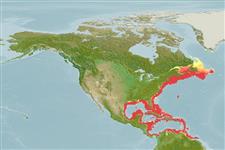>
Anguilliformes (Eels and morays) >
Anguillidae (Freshwater eels)
Etymology: Anguilla: Latin, anguilla, .-ae = eel (Ref. 45335); rostrata: From the words Anguilla-Latin for eel and rostrata, meaning long nose (Ref. 10294).
More on author: Lesueur.
Environment: milieu / climate zone / depth range / distribution range
بوم شناسي
دريايي; آب شيرين; لب شور نزديك كف زي; دريا كوچ (Ref. 26938); تغييرات عمق 0 - 464 m (Ref. 57178). Subtropical; 4°C - 25°C (Ref. 12468); 66°N - 5°N, 98°W - 21°W
Northwest to western Central Atlantic: Greenland south along the Atlantic coast of Canada and the USA to Panama, and throughout much of the West Indies south to Trinidad.
Length at first maturity / Size / Weight / سن
Maturity: Lm 68.5, range 37 - 100 cm
Max length : 152 cm TL جنس نر / بدون خواص جنسي; (Ref. 26938); 122.0 cm TL (female); common length : 50.0 cm TL جنس نر / بدون خواص جنسي; (Ref. 3242); بيشينه وزن گزارش شده: 7.3 kg (Ref. 4699); بيشينه سن گزارش شده: 43 سال ها (Ref. 40922)
خارهاي باله پشتي (کل) : 0; خارهاي باله مخرجي: 0. Head rather long; eyes small and placed well forward on head. Lips thick. Caudal vertebrae without transverse processes. Premaxillae not developed as distinct elements in adults. Frontal bones paired, not grown together. Pectoral girdle with 7 to 9 (up to 11 in the young) radial elements. Adults usually white or light-colored below and brownish to blue-black above, but coloration is variable; young with some yellow on the edges of the dorsal and anal fins (Ref. 30499). Caudal fin rounded, joined to dorsal and anal fins. Gill opening on side in front of lower half of well-developed pectoral fin; lower jaw longer than upper; 103-111 vertebrae (Ref. 26938).
Occurs in streams, rivers, muddy or silt-bottomed lakes (Ref. 5951); usually in permanent streams with continuous flow (Ref. 86798). Hides during the day in undercut banks and in deep pools near logs and boulders (Ref. 86798). Feeds on larvae of Ephemeroptera, Odonata, Plecoptera, Coleoptera, Trichoptera, and Lepidoptera, as well as gastropods, oligochaetes, amphipods, isopods, mysids, and fish from the families Percidae, Cyprinidae, Ictaluridae, Catostomidae and Anguillidae (Ref. 9593). Migrates in autumn to the Sargasso Sea to spawn (Ref. 3242). Sexual maturity occurs approximately in less than10 years and up to 40 years in freshwater (Ref. 57533). Larvae (transparent leptocephali shaped somewhat like a willow leaf) hatch and develop at sea to metamorphose into elvers in nearshore waters and estuaries (Ref. 57533). Adults are caught with eel pots and trot lines. Elvers and glass eels are caught with fine mesh fyke nets and dipnets. Catadromous species. (Ref. 26938). Maximum depth reported taken from Ref. 57178.
Undertakes migration in autumn to the Sargasso Sea where spawning is said to take place. Coloration changes with sexual maturation. Dorsal surface of the pectorals becomes dark, lateral line becomes prominent, eye diameter increases and visual pigments change, body takes on a silvery bronze coloration. Females are usually larger than males and migrate much farther upstream (Ref. 57533). Adults die after spawning (Ref. 30499).
Spawn at sea but growth occurs in estuaries or freshwater (Ref. 7135). Spawning grounds believed to be between 20° and 30°N and 60°and 75°W (Ref. 40916, 40917).
Page, L.M. and B.M. Burr, 1991. A field guide to freshwater fishes of North America north of Mexico. Houghton Mifflin Company, Boston. 432 p. (Ref. 5723)
وضعيت در فهرست قرمز IUCN (Ref. 130435: Version 2024-1)
خطر برای انسان ها
Harmless
استفاده انسانی
ماهي گيري – شيلات: تجاري; آبزي پروري: تجاري; ماهي ها ي سرگرم كننده: بله; آكواريوم: آکواریوم عمومی
ابزارها
گزارش های ويژه
بارگيری XML
منابع اينترنتي
Estimates based on models
Preferred temperature (Ref.
123201): 0.5 - 24.3, mean 6.3 °C (based on 323 cells).
Phylogenetic diversity index (Ref.
82804): PD
50 = 0.5000 [Uniqueness, from 0.5 = low to 2.0 = high].
Bayesian length-weight: a=0.00087 (0.00070 - 0.00108), b=3.18 (3.13 - 3.23), in cm total length, based on LWR estimates for this species (Ref.
93245).
Trophic level (Ref.
69278): 3.8 ±0.2 se; based on diet studies.
جهندگی (Ref.
120179): پايين ، كم, كمينه زمان لازم براي دو برابر شدن جمعيت 5/4 – 14 سال (tm=3-6; tmax=43; Fec=5,000,000).
Fishing Vulnerability (Ref.
59153): High to very high vulnerability (72 of 100).
Climate Vulnerability (Ref.
125649): High vulnerability (60 of 100).
Nutrients (Ref.
124155): Calcium = 32.2 [19.9, 67.1] mg/100g; Iron = 0.734 [0.430, 1.146] mg/100g; Protein = 19.6 [17.8, 21.5] %; Omega3 = 0.367 [0.197, 0.697] g/100g; Selenium = 56 [29, 105] μg/100g; VitaminA = 8.64 [1.82, 42.50] μg/100g; Zinc = 0.64 [0.46, 0.92] mg/100g (wet weight); based on
nutrient studies.
